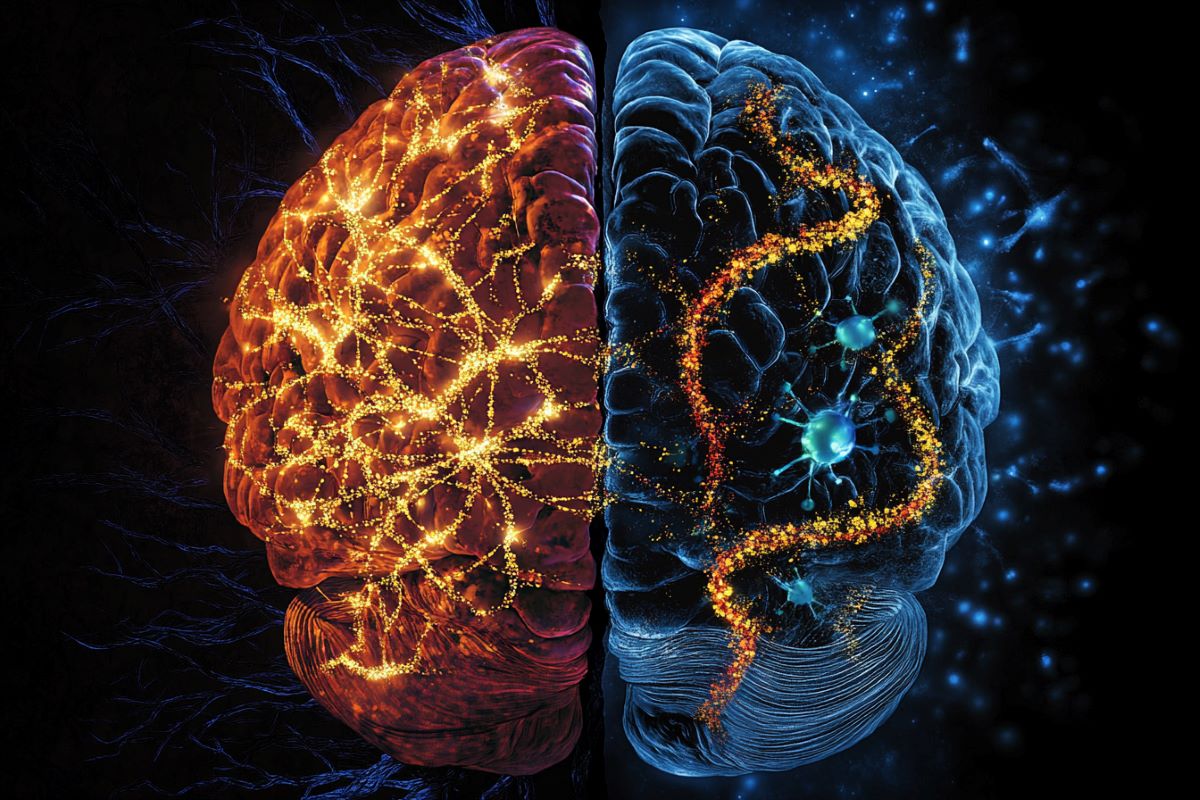Summary: While humans share over 95% of their genome with chimpanzees, our brains are far more complex due to differences in gene expression. Research shows that human brain cells, particularly glial cells, exhibit higher levels of upregulated genes, enhancing neural plasticity and development.
Oligodendrocytes, a glial cell type, play a key role by insulating neurons for faster and more efficient signaling. This study underscores that the evolution of human intelligence likely involved coordinated changes across all brain cell types, not just neurons.
Key Facts:
- Gene Expression: Human brain cells show higher levels of gene activity compared to chimpanzees.
- Glial Cell Role: Differences in oligodendrocyte gene expression may enhance neural plasticity and efficiency.
- Evolutionary Insight: Human brain complexity evolved through specialized gene expression across cell types.
Source: UC Santa Barbara
Our brain is arguably the organ that most distinguishes humans from other primates. Its exceptional size, complexity and capabilities far exceed those of any other species on Earth. Yet humans share upwards of 95% of our genome with chimpanzees, our closest living relatives.
UC Santa Barbara professor Soojin Yi, in the Department of Ecology, Evolution, and Marine Biology, her doctoral student Dennis Joshy and collaborator Gabriel Santepere, at Hospital del Mar Medical Research Institute in Barcelona, aimed to determine how genes in different types of brain cells have evolved compared to those in chimpanzees.

They found that, while our genes code for almost all the same proteins as other apes, many of our genes are much more productive than those of other primates.
Their results, published in the Proceedings of the National Academy of Sciences, highlight the role of gene expression in the evolution and function of the human brain.
Interpreting nature’s blueprints
Each gene tells a cell to make a specific molecule, but this isn’t performed by the DNA itself. Instead, the information is relayed to cellular machinery by a molecule called messenger RNA. Researchers measure gene expression by observing the amount of mRNA a specific gene produces.
As scientists began to understand the role of the genome as life’s blueprint, they thought perhaps the human genome could explain our unique traits. But a thorough comparison with chimpanzees in 2005 revealed we share 99% percent of our genes (though scientists have since revised this number).
This confirmed earlier studies based on small numbers of genes that had suggested there was only a small difference between the human and chimpanzee genome.
Now biologists suspect that gene expression may underlie these differences. Consider a monarch butterfly. The adult has the same genome as when it was a caterpillar.
The incredible differences between the two life stages all come down to gene expression. Turning on and off different genes, or having them code for more or less mRNA, can drastically alter an organism’s traits.
Getting a clearer picture
Previous research has found differences in gene expression between humans and chimpanzees, and that human cells tend to have higher gene expression, but the picture was blurry.
The brain is made up of many varieties of cells. Traditionally, scientists organized brain cells into two major types: neurons and glial cells. Neurons carry electrochemical signals, a bit like the copper wiring in a building.
Glial cells perform most of the other functions, such as insulating the wires, supporting the structure and clearing out debris.
Until recently, scientists could only study bulk tissue samples composed of many different types of cells. But within the past decade, it’s become possible to assay cell nuclei one at a time. This allows researchers to distinguish between cell types, and often even subtypes.
Yi, Joshy and Santepere used datasets generated from a device with a very narrow channel to separate each nucleus into its own chamber in an array. Then they grouped the cells by type before performing statistical analysis
The team measured gene expression by observing the amount of mRNA a specific gene produced in humans, chimpanzees and macaques. An upregulated gene produces more mRNA in a given species compared to the others, while a downregulated gene produces less.
Comparing chimpanzees and humans to macaques enabled the researchers to tell when differences between the two apes were due to changes in chimpanzees, changes in humans, or both.
The authors recorded differences in the expression of about 5-10% of the 25,000 genes in the study. In general, human cells had more upregulated genes compared to chimpanzees.
This is a much larger percentage than researchers found when they couldn’t break down the analysis by cell type. And the percentage grew to 12-15% when the authors began to consider cell subtypes.
“Now we can see that individual cell types have their own evolutionary path, becoming really specialized,” Yi said.
Not just neurons
The intricacy of our neural pathways is unrivaled in the animal kingdom, however Yi suspects that our unique intellect isn’t a result of this on its own.
Human glial cells account for more than half of the cells in our brains, a much larger percentage than in even chimpanzees.
Among glial cells, oligodendrocytes showed the greatest differences in gene expression. These cells create the insulation that coats neurons, enabling their electrical signals to travel much more quickly and efficiently.
In a collaborative study published the previous year, the team observed that humans have a higher ratio of precursor versus mature oligodendrocytes compared with chimpanzees.
Yi suspects this may relate to the amazing neural plasticity and slow development of human brains.
“The increased complexity of our neural network probably didn’t evolve alone,” Yi said.
“It could not come to existence unless all these other cell types also evolved and enabled the expansion of the neuron diversity, the number of neurons and the complexity of the networks.”
This study only considered cells from a few regions of the brain; however, the cells in one area of the brain may differ from their counterparts in other areas. Yi plans to study the mechanisms behind differences in gene expression and how genes map to different traits.
She also plans to trace differential gene expression even earlier in our evolutionary history by incorporating baselines from even more distantly related animals. And she’s interested in studying genomic differences between us and other archaic humans, like Neanderthals and Denisovans.
Evolution is about more than merely changing genes. “Differential gene expression is really how human brains evolved,” Yi said.
About this genetics and evolutionary neuroscience research news
Author: Harrison Tasoff
Source: UC Santa Barbara
Contact: Harrison Tasoff – UC Santa Barbara
Image: The image is credited to Neuroscience News
Original Research: Open access.
“Accelerated cell-type-specific regulatory evolution of the human brain” by Soojin Yi et al. PNAS
Abstract
Accelerated cell-type-specific regulatory evolution of the human brain
The molecular basis of human brain evolution is a key piece in understanding the evolution of human-specific cognitive and behavioral traits.
Comparative studies have suggested that human brain evolution was accompanied by accelerated changes of gene expression (referred to as “regulatory evolution”), especially those leading to an increase of gene products involved in energy production and metabolism.
However, the signals of accelerated regulatory evolution were not always consistent across studies. One confounding factor is the diversity of distinctive cell types in the human brain.
Here, we leveraged single-cell human and nonhuman primate transcriptomic data to investigate regulatory evolution at cell-type resolution.
We relied on six well-established major cell types: excitatory and inhibitory neurons, astrocytes, microglia, oligodendrocytes, and oligodendrocyte precursor cells.
We found pervasive signatures of accelerated regulatory evolution in the human brains compared to the chimpanzee brains in the major six cell types, as well as across multiple neuronal subtypes.
Moreover, regulatory evolution is highly cell type specific rather than shared between cell types and strongly associated with cellular-level epigenomic features.
Evolutionarily differentially expressed genes (DEGs) exhibit greater cell-type specificity than other genes, suggesting their role in the functional specialization of individual cell types in the human brain.
As we continue to unfold the cellular complexity of the brain, the actual scope of DEGs in the human brain appears to be much broader than previously estimated.
Our study supports the acceleration of cell-type-specific functional programs as an important feature of human brain evolution.







